Hospitality Business Strategy
VerifiedAdded on 2023/01/11
|13
|4118
|79
AI Summary
This report analyzes the impact of macro environment on a hospitality organization's strategy, explores internal capabilities and competitive forces in the market sector, and devises a strategic planning for the organization.
Contribute Materials
Your contribution can guide someone’s learning journey. Share your
documents today.
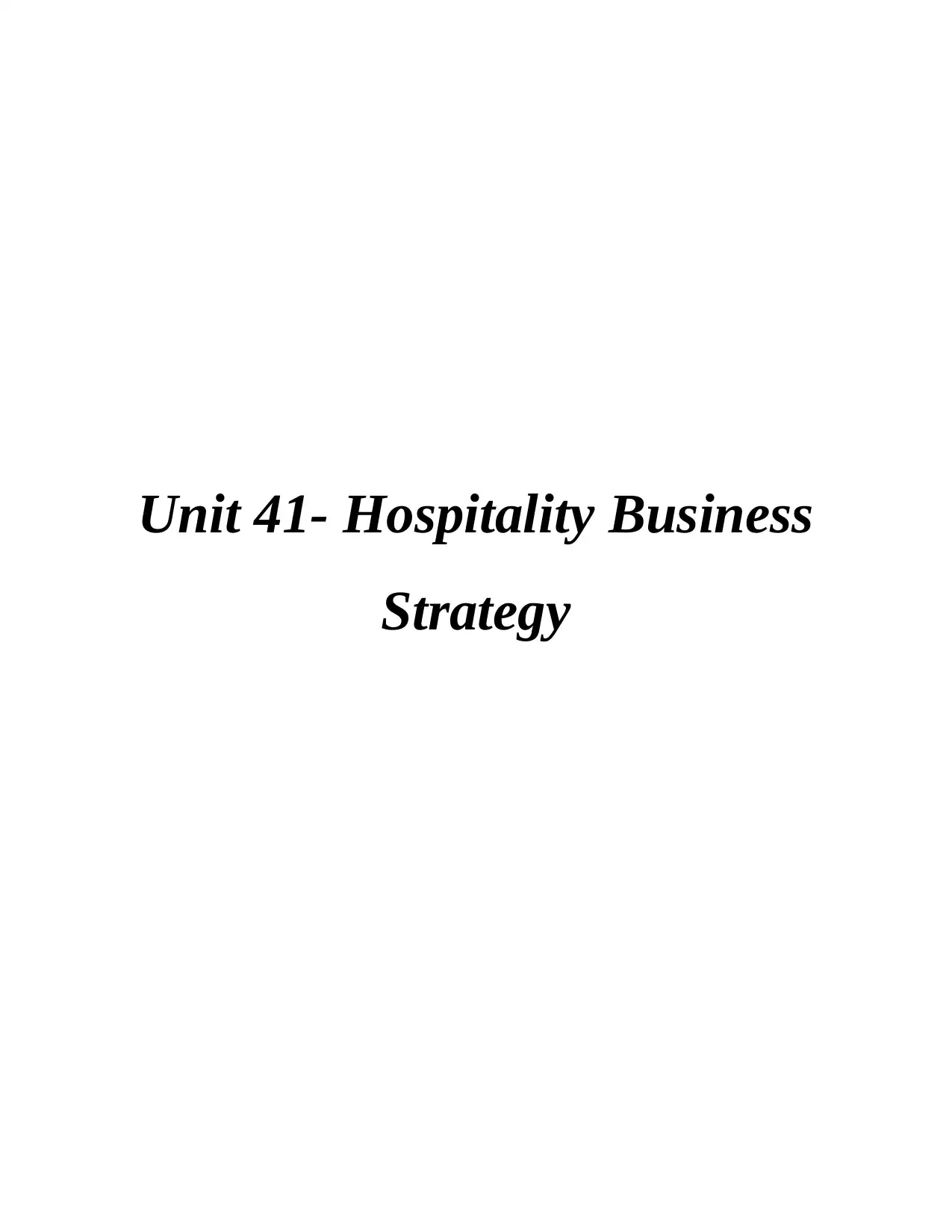
Unit 41- Hospitality Business
Strategy
Strategy
Secure Best Marks with AI Grader
Need help grading? Try our AI Grader for instant feedback on your assignments.
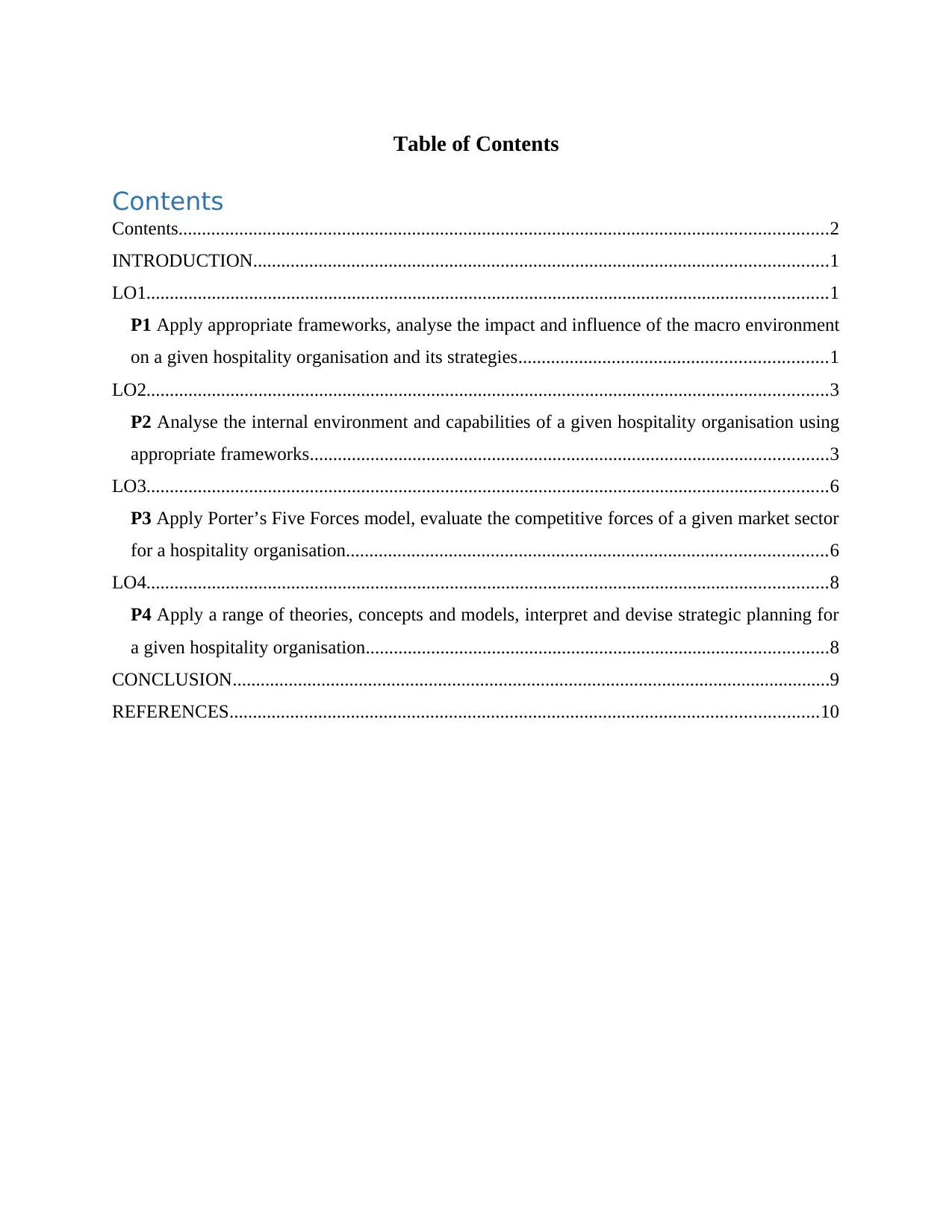
Table of Contents
Contents
Contents...........................................................................................................................................2
INTRODUCTION...........................................................................................................................1
LO1..................................................................................................................................................1
P1 Apply appropriate frameworks, analyse the impact and influence of the macro environment
on a given hospitality organisation and its strategies..................................................................1
LO2..................................................................................................................................................3
P2 Analyse the internal environment and capabilities of a given hospitality organisation using
appropriate frameworks...............................................................................................................3
LO3..................................................................................................................................................6
P3 Apply Porter’s Five Forces model, evaluate the competitive forces of a given market sector
for a hospitality organisation.......................................................................................................6
LO4..................................................................................................................................................8
P4 Apply a range of theories, concepts and models, interpret and devise strategic planning for
a given hospitality organisation...................................................................................................8
CONCLUSION................................................................................................................................9
REFERENCES..............................................................................................................................10
Contents
Contents...........................................................................................................................................2
INTRODUCTION...........................................................................................................................1
LO1..................................................................................................................................................1
P1 Apply appropriate frameworks, analyse the impact and influence of the macro environment
on a given hospitality organisation and its strategies..................................................................1
LO2..................................................................................................................................................3
P2 Analyse the internal environment and capabilities of a given hospitality organisation using
appropriate frameworks...............................................................................................................3
LO3..................................................................................................................................................6
P3 Apply Porter’s Five Forces model, evaluate the competitive forces of a given market sector
for a hospitality organisation.......................................................................................................6
LO4..................................................................................................................................................8
P4 Apply a range of theories, concepts and models, interpret and devise strategic planning for
a given hospitality organisation...................................................................................................8
CONCLUSION................................................................................................................................9
REFERENCES..............................................................................................................................10
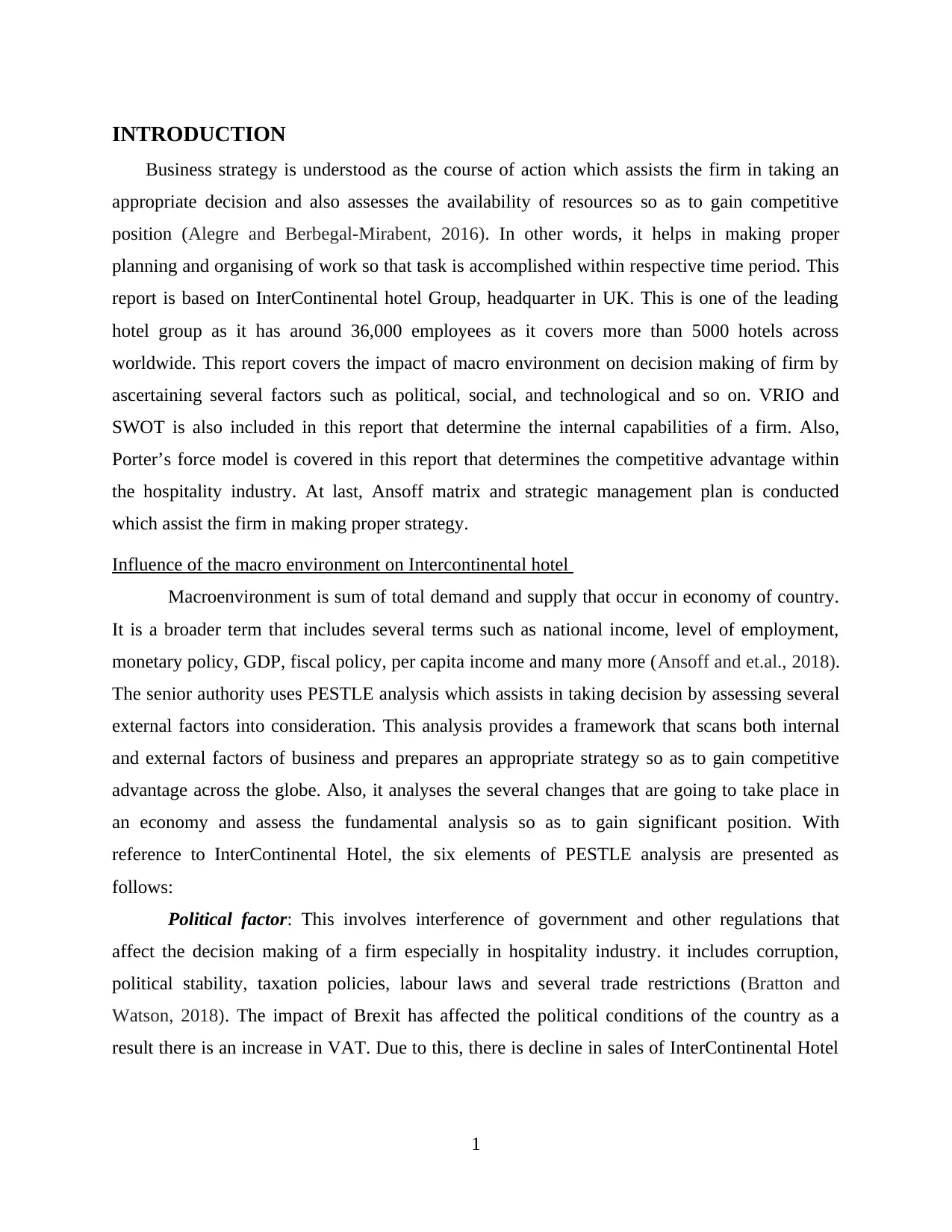
INTRODUCTION
Business strategy is understood as the course of action which assists the firm in taking an
appropriate decision and also assesses the availability of resources so as to gain competitive
position (Alegre and Berbegal-Mirabent, 2016). In other words, it helps in making proper
planning and organising of work so that task is accomplished within respective time period. This
report is based on InterContinental hotel Group, headquarter in UK. This is one of the leading
hotel group as it has around 36,000 employees as it covers more than 5000 hotels across
worldwide. This report covers the impact of macro environment on decision making of firm by
ascertaining several factors such as political, social, and technological and so on. VRIO and
SWOT is also included in this report that determine the internal capabilities of a firm. Also,
Porter’s force model is covered in this report that determines the competitive advantage within
the hospitality industry. At last, Ansoff matrix and strategic management plan is conducted
which assist the firm in making proper strategy.
Influence of the macro environment on Intercontinental hotel
Macroenvironment is sum of total demand and supply that occur in economy of country.
It is a broader term that includes several terms such as national income, level of employment,
monetary policy, GDP, fiscal policy, per capita income and many more (Ansoff and et.al., 2018).
The senior authority uses PESTLE analysis which assists in taking decision by assessing several
external factors into consideration. This analysis provides a framework that scans both internal
and external factors of business and prepares an appropriate strategy so as to gain competitive
advantage across the globe. Also, it analyses the several changes that are going to take place in
an economy and assess the fundamental analysis so as to gain significant position. With
reference to InterContinental Hotel, the six elements of PESTLE analysis are presented as
follows:
Political factor: This involves interference of government and other regulations that
affect the decision making of a firm especially in hospitality industry. it includes corruption,
political stability, taxation policies, labour laws and several trade restrictions (Bratton and
Watson, 2018). The impact of Brexit has affected the political conditions of the country as a
result there is an increase in VAT. Due to this, there is decline in sales of InterContinental Hotel
1
Business strategy is understood as the course of action which assists the firm in taking an
appropriate decision and also assesses the availability of resources so as to gain competitive
position (Alegre and Berbegal-Mirabent, 2016). In other words, it helps in making proper
planning and organising of work so that task is accomplished within respective time period. This
report is based on InterContinental hotel Group, headquarter in UK. This is one of the leading
hotel group as it has around 36,000 employees as it covers more than 5000 hotels across
worldwide. This report covers the impact of macro environment on decision making of firm by
ascertaining several factors such as political, social, and technological and so on. VRIO and
SWOT is also included in this report that determine the internal capabilities of a firm. Also,
Porter’s force model is covered in this report that determines the competitive advantage within
the hospitality industry. At last, Ansoff matrix and strategic management plan is conducted
which assist the firm in making proper strategy.
Influence of the macro environment on Intercontinental hotel
Macroenvironment is sum of total demand and supply that occur in economy of country.
It is a broader term that includes several terms such as national income, level of employment,
monetary policy, GDP, fiscal policy, per capita income and many more (Ansoff and et.al., 2018).
The senior authority uses PESTLE analysis which assists in taking decision by assessing several
external factors into consideration. This analysis provides a framework that scans both internal
and external factors of business and prepares an appropriate strategy so as to gain competitive
advantage across the globe. Also, it analyses the several changes that are going to take place in
an economy and assess the fundamental analysis so as to gain significant position. With
reference to InterContinental Hotel, the six elements of PESTLE analysis are presented as
follows:
Political factor: This involves interference of government and other regulations that
affect the decision making of a firm especially in hospitality industry. it includes corruption,
political stability, taxation policies, labour laws and several trade restrictions (Bratton and
Watson, 2018). The impact of Brexit has affected the political conditions of the country as a
result there is an increase in VAT. Due to this, there is decline in sales of InterContinental Hotel
1
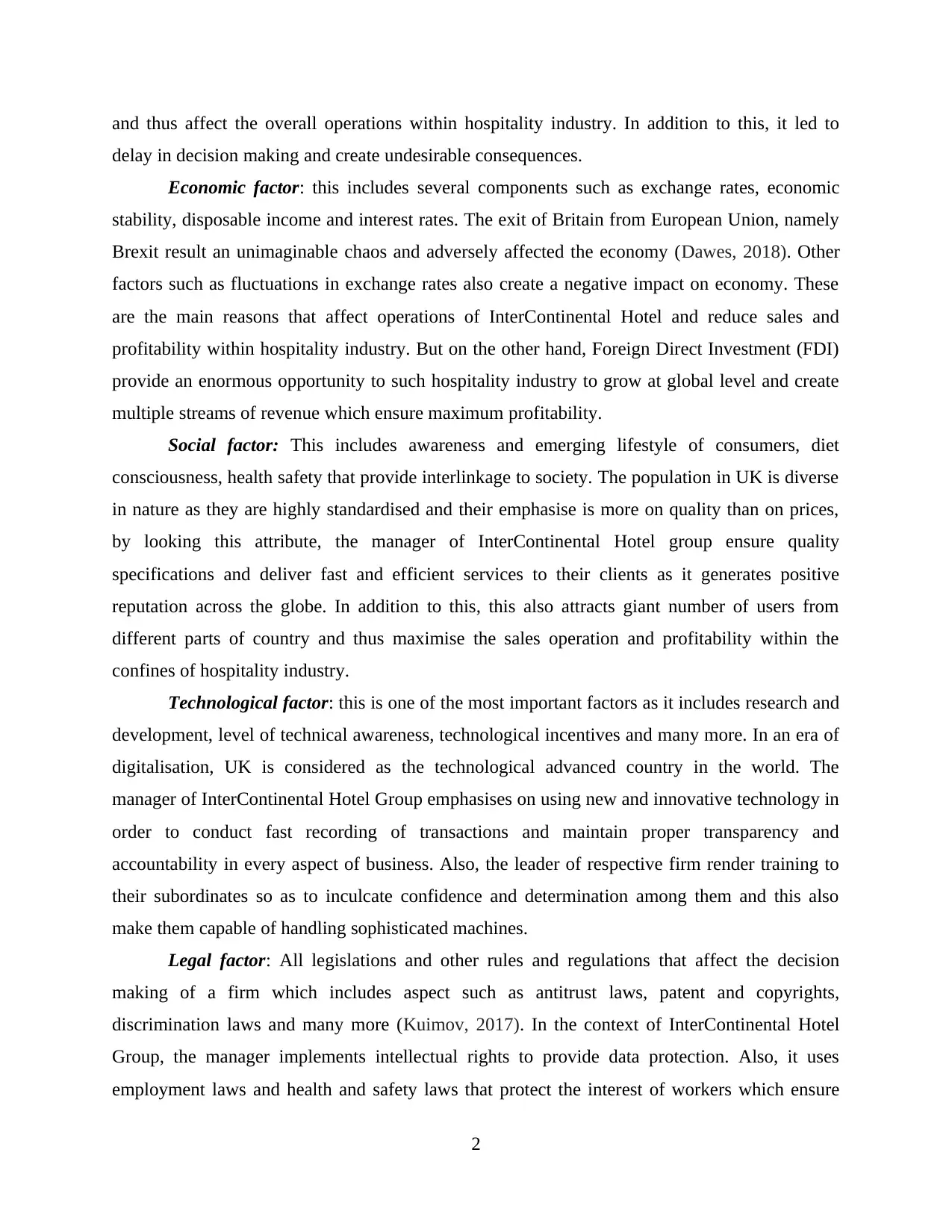
and thus affect the overall operations within hospitality industry. In addition to this, it led to
delay in decision making and create undesirable consequences.
Economic factor: this includes several components such as exchange rates, economic
stability, disposable income and interest rates. The exit of Britain from European Union, namely
Brexit result an unimaginable chaos and adversely affected the economy (Dawes, 2018). Other
factors such as fluctuations in exchange rates also create a negative impact on economy. These
are the main reasons that affect operations of InterContinental Hotel and reduce sales and
profitability within hospitality industry. But on the other hand, Foreign Direct Investment (FDI)
provide an enormous opportunity to such hospitality industry to grow at global level and create
multiple streams of revenue which ensure maximum profitability.
Social factor: This includes awareness and emerging lifestyle of consumers, diet
consciousness, health safety that provide interlinkage to society. The population in UK is diverse
in nature as they are highly standardised and their emphasise is more on quality than on prices,
by looking this attribute, the manager of InterContinental Hotel group ensure quality
specifications and deliver fast and efficient services to their clients as it generates positive
reputation across the globe. In addition to this, this also attracts giant number of users from
different parts of country and thus maximise the sales operation and profitability within the
confines of hospitality industry.
Technological factor: this is one of the most important factors as it includes research and
development, level of technical awareness, technological incentives and many more. In an era of
digitalisation, UK is considered as the technological advanced country in the world. The
manager of InterContinental Hotel Group emphasises on using new and innovative technology in
order to conduct fast recording of transactions and maintain proper transparency and
accountability in every aspect of business. Also, the leader of respective firm render training to
their subordinates so as to inculcate confidence and determination among them and this also
make them capable of handling sophisticated machines.
Legal factor: All legislations and other rules and regulations that affect the decision
making of a firm which includes aspect such as antitrust laws, patent and copyrights,
discrimination laws and many more (Kuimov, 2017). In the context of InterContinental Hotel
Group, the manager implements intellectual rights to provide data protection. Also, it uses
employment laws and health and safety laws that protect the interest of workers which ensure
2
delay in decision making and create undesirable consequences.
Economic factor: this includes several components such as exchange rates, economic
stability, disposable income and interest rates. The exit of Britain from European Union, namely
Brexit result an unimaginable chaos and adversely affected the economy (Dawes, 2018). Other
factors such as fluctuations in exchange rates also create a negative impact on economy. These
are the main reasons that affect operations of InterContinental Hotel and reduce sales and
profitability within hospitality industry. But on the other hand, Foreign Direct Investment (FDI)
provide an enormous opportunity to such hospitality industry to grow at global level and create
multiple streams of revenue which ensure maximum profitability.
Social factor: This includes awareness and emerging lifestyle of consumers, diet
consciousness, health safety that provide interlinkage to society. The population in UK is diverse
in nature as they are highly standardised and their emphasise is more on quality than on prices,
by looking this attribute, the manager of InterContinental Hotel group ensure quality
specifications and deliver fast and efficient services to their clients as it generates positive
reputation across the globe. In addition to this, this also attracts giant number of users from
different parts of country and thus maximise the sales operation and profitability within the
confines of hospitality industry.
Technological factor: this is one of the most important factors as it includes research and
development, level of technical awareness, technological incentives and many more. In an era of
digitalisation, UK is considered as the technological advanced country in the world. The
manager of InterContinental Hotel Group emphasises on using new and innovative technology in
order to conduct fast recording of transactions and maintain proper transparency and
accountability in every aspect of business. Also, the leader of respective firm render training to
their subordinates so as to inculcate confidence and determination among them and this also
make them capable of handling sophisticated machines.
Legal factor: All legislations and other rules and regulations that affect the decision
making of a firm which includes aspect such as antitrust laws, patent and copyrights,
discrimination laws and many more (Kuimov, 2017). In the context of InterContinental Hotel
Group, the manager implements intellectual rights to provide data protection. Also, it uses
employment laws and health and safety laws that protect the interest of workers which ensure
2
Secure Best Marks with AI Grader
Need help grading? Try our AI Grader for instant feedback on your assignments.
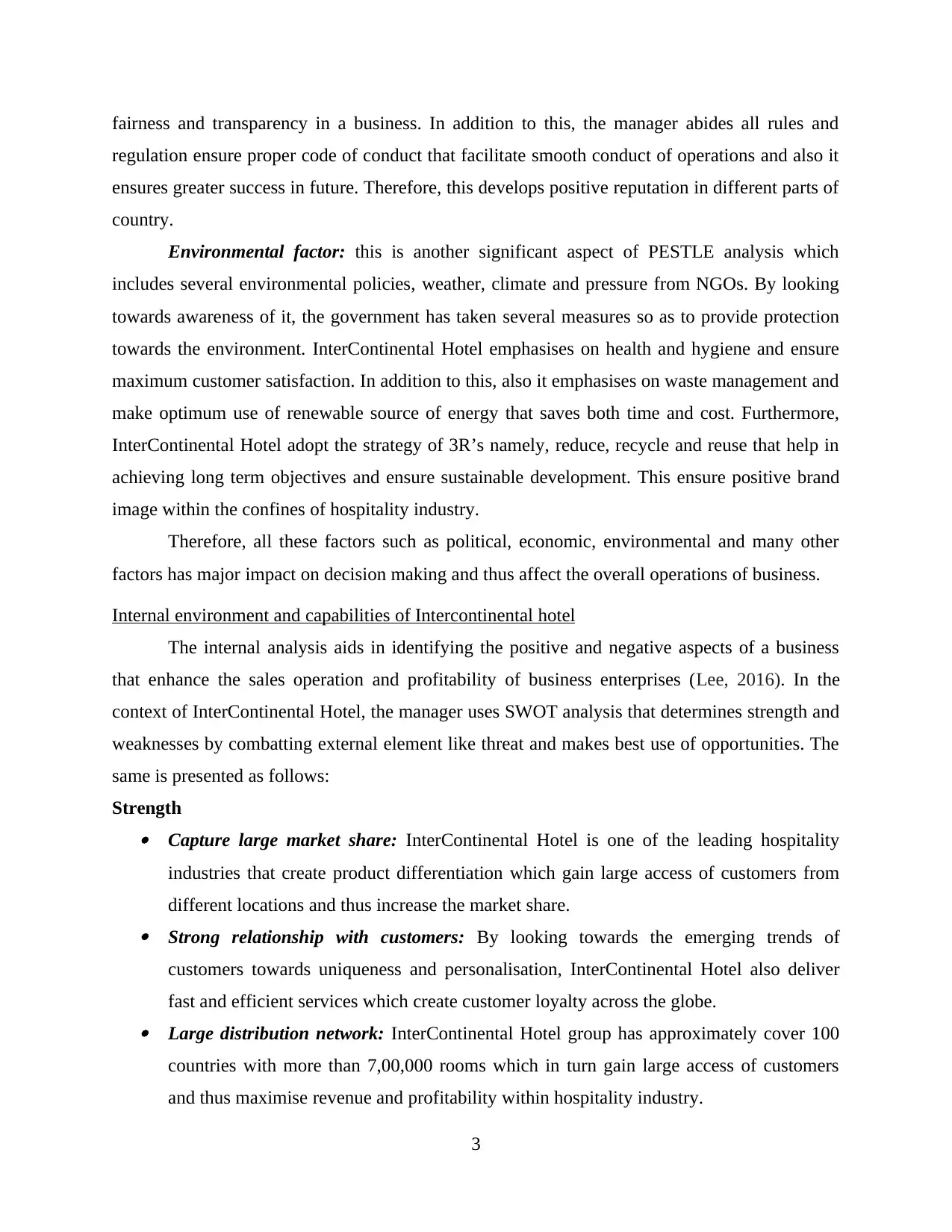
fairness and transparency in a business. In addition to this, the manager abides all rules and
regulation ensure proper code of conduct that facilitate smooth conduct of operations and also it
ensures greater success in future. Therefore, this develops positive reputation in different parts of
country.
Environmental factor: this is another significant aspect of PESTLE analysis which
includes several environmental policies, weather, climate and pressure from NGOs. By looking
towards awareness of it, the government has taken several measures so as to provide protection
towards the environment. InterContinental Hotel emphasises on health and hygiene and ensure
maximum customer satisfaction. In addition to this, also it emphasises on waste management and
make optimum use of renewable source of energy that saves both time and cost. Furthermore,
InterContinental Hotel adopt the strategy of 3R’s namely, reduce, recycle and reuse that help in
achieving long term objectives and ensure sustainable development. This ensure positive brand
image within the confines of hospitality industry.
Therefore, all these factors such as political, economic, environmental and many other
factors has major impact on decision making and thus affect the overall operations of business.
Internal environment and capabilities of Intercontinental hotel
The internal analysis aids in identifying the positive and negative aspects of a business
that enhance the sales operation and profitability of business enterprises (Lee, 2016). In the
context of InterContinental Hotel, the manager uses SWOT analysis that determines strength and
weaknesses by combatting external element like threat and makes best use of opportunities. The
same is presented as follows:
Strength Capture large market share: InterContinental Hotel is one of the leading hospitality
industries that create product differentiation which gain large access of customers from
different locations and thus increase the market share. Strong relationship with customers: By looking towards the emerging trends of
customers towards uniqueness and personalisation, InterContinental Hotel also deliver
fast and efficient services which create customer loyalty across the globe. Large distribution network: InterContinental Hotel group has approximately cover 100
countries with more than 7,00,000 rooms which in turn gain large access of customers
and thus maximise revenue and profitability within hospitality industry.
3
regulation ensure proper code of conduct that facilitate smooth conduct of operations and also it
ensures greater success in future. Therefore, this develops positive reputation in different parts of
country.
Environmental factor: this is another significant aspect of PESTLE analysis which
includes several environmental policies, weather, climate and pressure from NGOs. By looking
towards awareness of it, the government has taken several measures so as to provide protection
towards the environment. InterContinental Hotel emphasises on health and hygiene and ensure
maximum customer satisfaction. In addition to this, also it emphasises on waste management and
make optimum use of renewable source of energy that saves both time and cost. Furthermore,
InterContinental Hotel adopt the strategy of 3R’s namely, reduce, recycle and reuse that help in
achieving long term objectives and ensure sustainable development. This ensure positive brand
image within the confines of hospitality industry.
Therefore, all these factors such as political, economic, environmental and many other
factors has major impact on decision making and thus affect the overall operations of business.
Internal environment and capabilities of Intercontinental hotel
The internal analysis aids in identifying the positive and negative aspects of a business
that enhance the sales operation and profitability of business enterprises (Lee, 2016). In the
context of InterContinental Hotel, the manager uses SWOT analysis that determines strength and
weaknesses by combatting external element like threat and makes best use of opportunities. The
same is presented as follows:
Strength Capture large market share: InterContinental Hotel is one of the leading hospitality
industries that create product differentiation which gain large access of customers from
different locations and thus increase the market share. Strong relationship with customers: By looking towards the emerging trends of
customers towards uniqueness and personalisation, InterContinental Hotel also deliver
fast and efficient services which create customer loyalty across the globe. Large distribution network: InterContinental Hotel group has approximately cover 100
countries with more than 7,00,000 rooms which in turn gain large access of customers
and thus maximise revenue and profitability within hospitality industry.
3
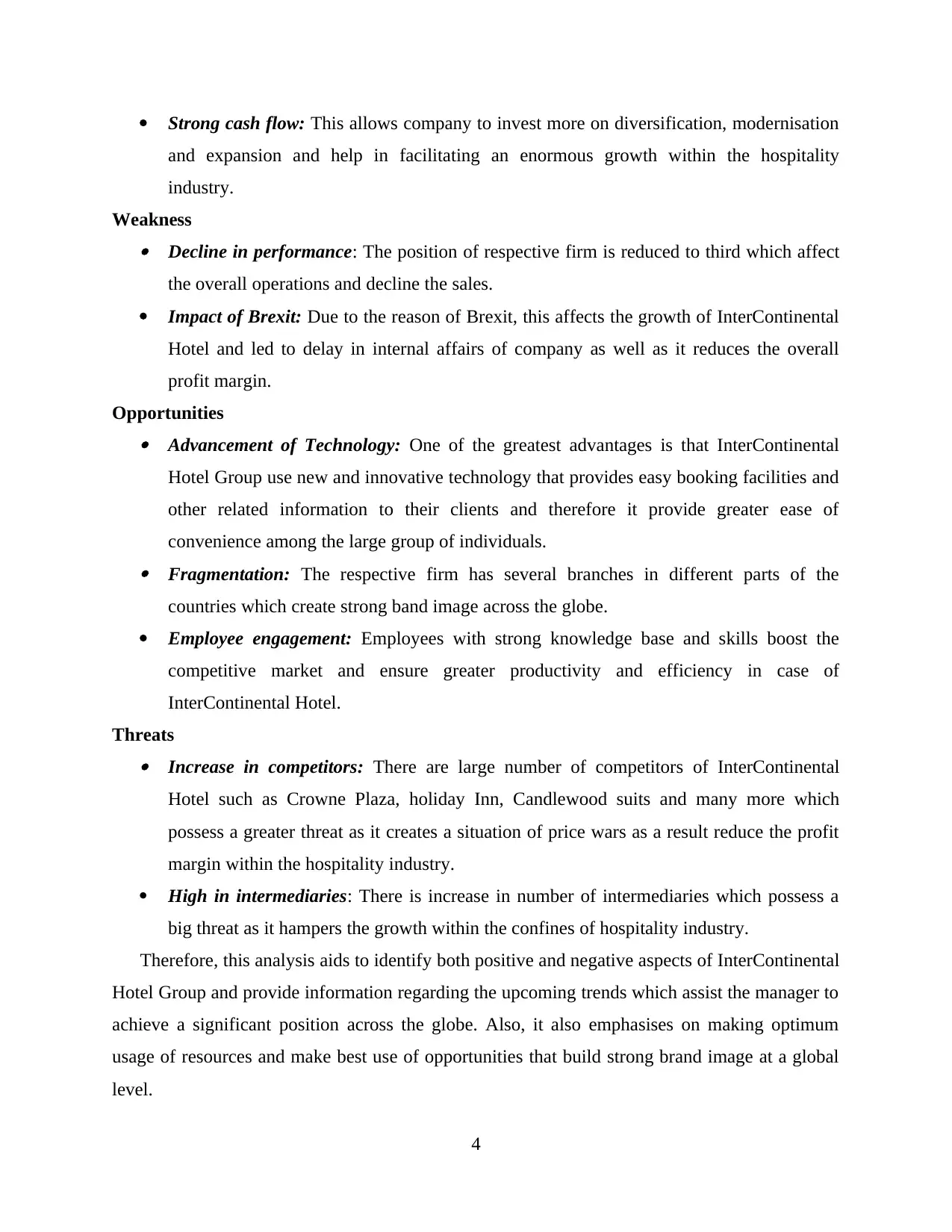
Strong cash flow: This allows company to invest more on diversification, modernisation
and expansion and help in facilitating an enormous growth within the hospitality
industry.
Weakness Decline in performance: The position of respective firm is reduced to third which affect
the overall operations and decline the sales.
Impact of Brexit: Due to the reason of Brexit, this affects the growth of InterContinental
Hotel and led to delay in internal affairs of company as well as it reduces the overall
profit margin.
Opportunities Advancement of Technology: One of the greatest advantages is that InterContinental
Hotel Group use new and innovative technology that provides easy booking facilities and
other related information to their clients and therefore it provide greater ease of
convenience among the large group of individuals. Fragmentation: The respective firm has several branches in different parts of the
countries which create strong band image across the globe.
Employee engagement: Employees with strong knowledge base and skills boost the
competitive market and ensure greater productivity and efficiency in case of
InterContinental Hotel.
Threats Increase in competitors: There are large number of competitors of InterContinental
Hotel such as Crowne Plaza, holiday Inn, Candlewood suits and many more which
possess a greater threat as it creates a situation of price wars as a result reduce the profit
margin within the hospitality industry.
High in intermediaries: There is increase in number of intermediaries which possess a
big threat as it hampers the growth within the confines of hospitality industry.
Therefore, this analysis aids to identify both positive and negative aspects of InterContinental
Hotel Group and provide information regarding the upcoming trends which assist the manager to
achieve a significant position across the globe. Also, it also emphasises on making optimum
usage of resources and make best use of opportunities that build strong brand image at a global
level.
4
and expansion and help in facilitating an enormous growth within the hospitality
industry.
Weakness Decline in performance: The position of respective firm is reduced to third which affect
the overall operations and decline the sales.
Impact of Brexit: Due to the reason of Brexit, this affects the growth of InterContinental
Hotel and led to delay in internal affairs of company as well as it reduces the overall
profit margin.
Opportunities Advancement of Technology: One of the greatest advantages is that InterContinental
Hotel Group use new and innovative technology that provides easy booking facilities and
other related information to their clients and therefore it provide greater ease of
convenience among the large group of individuals. Fragmentation: The respective firm has several branches in different parts of the
countries which create strong band image across the globe.
Employee engagement: Employees with strong knowledge base and skills boost the
competitive market and ensure greater productivity and efficiency in case of
InterContinental Hotel.
Threats Increase in competitors: There are large number of competitors of InterContinental
Hotel such as Crowne Plaza, holiday Inn, Candlewood suits and many more which
possess a greater threat as it creates a situation of price wars as a result reduce the profit
margin within the hospitality industry.
High in intermediaries: There is increase in number of intermediaries which possess a
big threat as it hampers the growth within the confines of hospitality industry.
Therefore, this analysis aids to identify both positive and negative aspects of InterContinental
Hotel Group and provide information regarding the upcoming trends which assist the manager to
achieve a significant position across the globe. Also, it also emphasises on making optimum
usage of resources and make best use of opportunities that build strong brand image at a global
level.
4
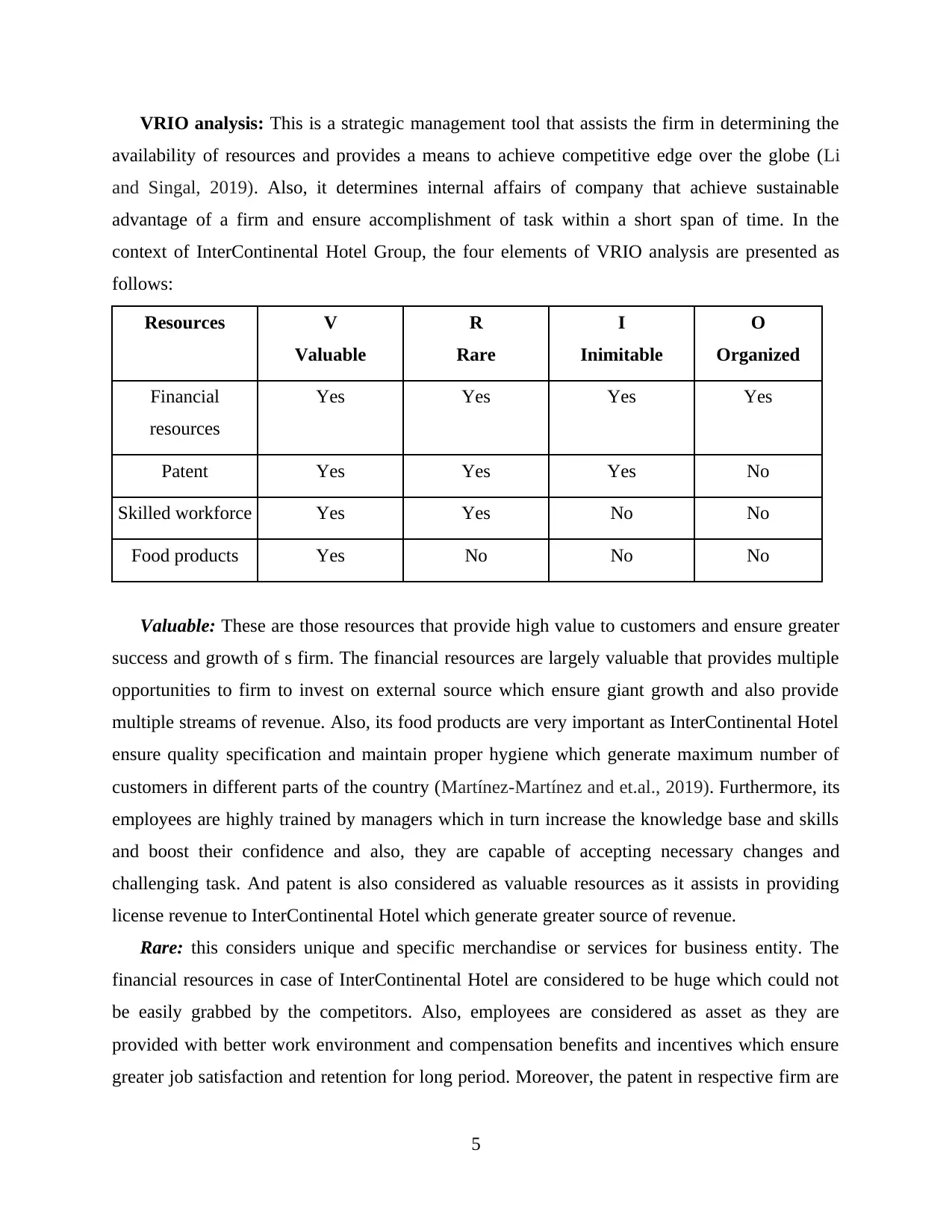
VRIO analysis: This is a strategic management tool that assists the firm in determining the
availability of resources and provides a means to achieve competitive edge over the globe (Li
and Singal, 2019). Also, it determines internal affairs of company that achieve sustainable
advantage of a firm and ensure accomplishment of task within a short span of time. In the
context of InterContinental Hotel Group, the four elements of VRIO analysis are presented as
follows:
Resources V
Valuable
R
Rare
I
Inimitable
O
Organized
Financial
resources
Yes Yes Yes Yes
Patent Yes Yes Yes No
Skilled workforce Yes Yes No No
Food products Yes No No No
Valuable: These are those resources that provide high value to customers and ensure greater
success and growth of s firm. The financial resources are largely valuable that provides multiple
opportunities to firm to invest on external source which ensure giant growth and also provide
multiple streams of revenue. Also, its food products are very important as InterContinental Hotel
ensure quality specification and maintain proper hygiene which generate maximum number of
customers in different parts of the country (Martínez-Martínez and et.al., 2019). Furthermore, its
employees are highly trained by managers which in turn increase the knowledge base and skills
and boost their confidence and also, they are capable of accepting necessary changes and
challenging task. And patent is also considered as valuable resources as it assists in providing
license revenue to InterContinental Hotel which generate greater source of revenue.
Rare: this considers unique and specific merchandise or services for business entity. The
financial resources in case of InterContinental Hotel are considered to be huge which could not
be easily grabbed by the competitors. Also, employees are considered as asset as they are
provided with better work environment and compensation benefits and incentives which ensure
greater job satisfaction and retention for long period. Moreover, the patent in respective firm are
5
availability of resources and provides a means to achieve competitive edge over the globe (Li
and Singal, 2019). Also, it determines internal affairs of company that achieve sustainable
advantage of a firm and ensure accomplishment of task within a short span of time. In the
context of InterContinental Hotel Group, the four elements of VRIO analysis are presented as
follows:
Resources V
Valuable
R
Rare
I
Inimitable
O
Organized
Financial
resources
Yes Yes Yes Yes
Patent Yes Yes Yes No
Skilled workforce Yes Yes No No
Food products Yes No No No
Valuable: These are those resources that provide high value to customers and ensure greater
success and growth of s firm. The financial resources are largely valuable that provides multiple
opportunities to firm to invest on external source which ensure giant growth and also provide
multiple streams of revenue. Also, its food products are very important as InterContinental Hotel
ensure quality specification and maintain proper hygiene which generate maximum number of
customers in different parts of the country (Martínez-Martínez and et.al., 2019). Furthermore, its
employees are highly trained by managers which in turn increase the knowledge base and skills
and boost their confidence and also, they are capable of accepting necessary changes and
challenging task. And patent is also considered as valuable resources as it assists in providing
license revenue to InterContinental Hotel which generate greater source of revenue.
Rare: this considers unique and specific merchandise or services for business entity. The
financial resources in case of InterContinental Hotel are considered to be huge which could not
be easily grabbed by the competitors. Also, employees are considered as asset as they are
provided with better work environment and compensation benefits and incentives which ensure
greater job satisfaction and retention for long period. Moreover, the patent in respective firm are
5
Paraphrase This Document
Need a fresh take? Get an instant paraphrase of this document with our AI Paraphraser
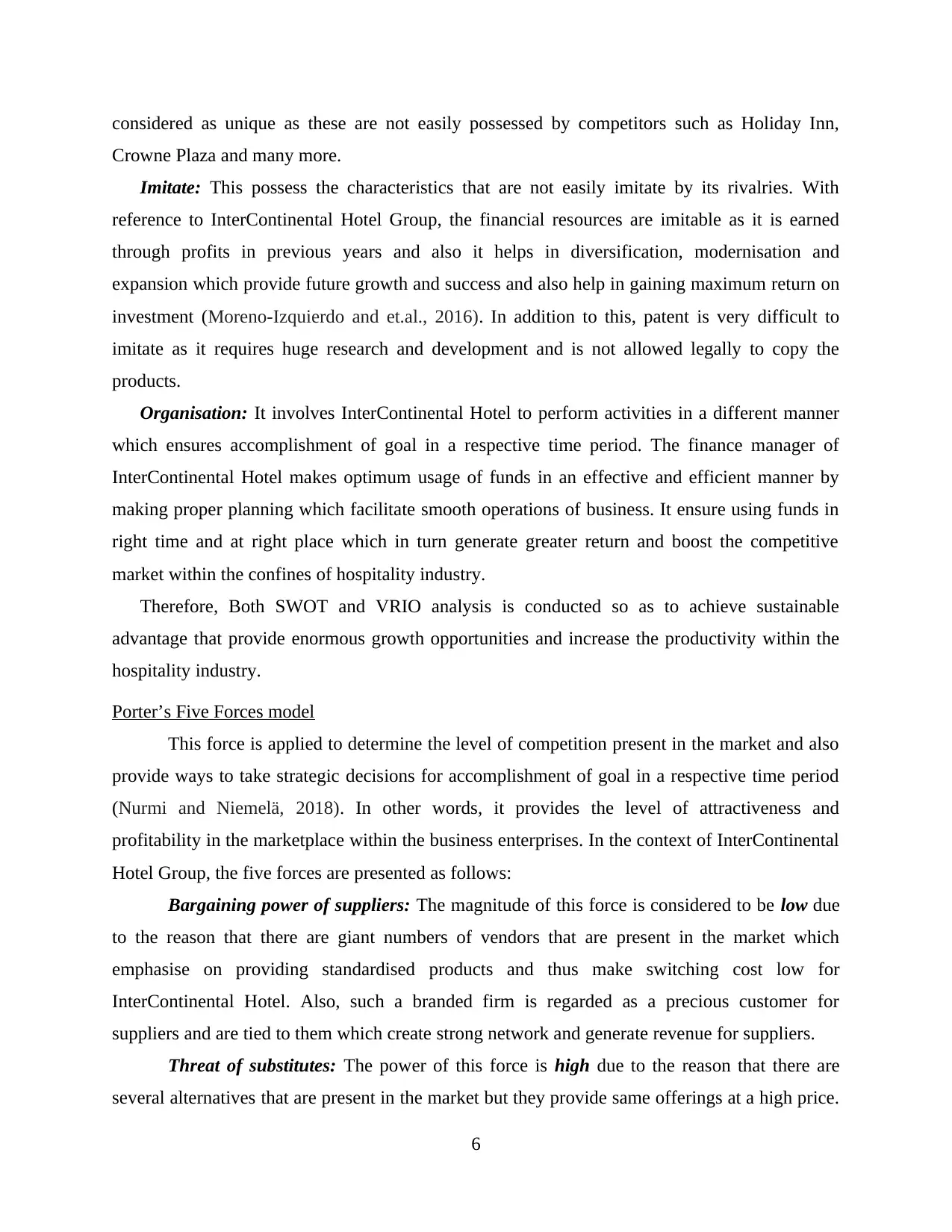
considered as unique as these are not easily possessed by competitors such as Holiday Inn,
Crowne Plaza and many more.
Imitate: This possess the characteristics that are not easily imitate by its rivalries. With
reference to InterContinental Hotel Group, the financial resources are imitable as it is earned
through profits in previous years and also it helps in diversification, modernisation and
expansion which provide future growth and success and also help in gaining maximum return on
investment (Moreno-Izquierdo and et.al., 2016). In addition to this, patent is very difficult to
imitate as it requires huge research and development and is not allowed legally to copy the
products.
Organisation: It involves InterContinental Hotel to perform activities in a different manner
which ensures accomplishment of goal in a respective time period. The finance manager of
InterContinental Hotel makes optimum usage of funds in an effective and efficient manner by
making proper planning which facilitate smooth operations of business. It ensure using funds in
right time and at right place which in turn generate greater return and boost the competitive
market within the confines of hospitality industry.
Therefore, Both SWOT and VRIO analysis is conducted so as to achieve sustainable
advantage that provide enormous growth opportunities and increase the productivity within the
hospitality industry.
Porter’s Five Forces model
This force is applied to determine the level of competition present in the market and also
provide ways to take strategic decisions for accomplishment of goal in a respective time period
(Nurmi and Niemelä, 2018). In other words, it provides the level of attractiveness and
profitability in the marketplace within the business enterprises. In the context of InterContinental
Hotel Group, the five forces are presented as follows:
Bargaining power of suppliers: The magnitude of this force is considered to be low due
to the reason that there are giant numbers of vendors that are present in the market which
emphasise on providing standardised products and thus make switching cost low for
InterContinental Hotel. Also, such a branded firm is regarded as a precious customer for
suppliers and are tied to them which create strong network and generate revenue for suppliers.
Threat of substitutes: The power of this force is high due to the reason that there are
several alternatives that are present in the market but they provide same offerings at a high price.
6
Crowne Plaza and many more.
Imitate: This possess the characteristics that are not easily imitate by its rivalries. With
reference to InterContinental Hotel Group, the financial resources are imitable as it is earned
through profits in previous years and also it helps in diversification, modernisation and
expansion which provide future growth and success and also help in gaining maximum return on
investment (Moreno-Izquierdo and et.al., 2016). In addition to this, patent is very difficult to
imitate as it requires huge research and development and is not allowed legally to copy the
products.
Organisation: It involves InterContinental Hotel to perform activities in a different manner
which ensures accomplishment of goal in a respective time period. The finance manager of
InterContinental Hotel makes optimum usage of funds in an effective and efficient manner by
making proper planning which facilitate smooth operations of business. It ensure using funds in
right time and at right place which in turn generate greater return and boost the competitive
market within the confines of hospitality industry.
Therefore, Both SWOT and VRIO analysis is conducted so as to achieve sustainable
advantage that provide enormous growth opportunities and increase the productivity within the
hospitality industry.
Porter’s Five Forces model
This force is applied to determine the level of competition present in the market and also
provide ways to take strategic decisions for accomplishment of goal in a respective time period
(Nurmi and Niemelä, 2018). In other words, it provides the level of attractiveness and
profitability in the marketplace within the business enterprises. In the context of InterContinental
Hotel Group, the five forces are presented as follows:
Bargaining power of suppliers: The magnitude of this force is considered to be low due
to the reason that there are giant numbers of vendors that are present in the market which
emphasise on providing standardised products and thus make switching cost low for
InterContinental Hotel. Also, such a branded firm is regarded as a precious customer for
suppliers and are tied to them which create strong network and generate revenue for suppliers.
Threat of substitutes: The power of this force is high due to the reason that there are
several alternatives that are present in the market but they provide same offerings at a high price.
6
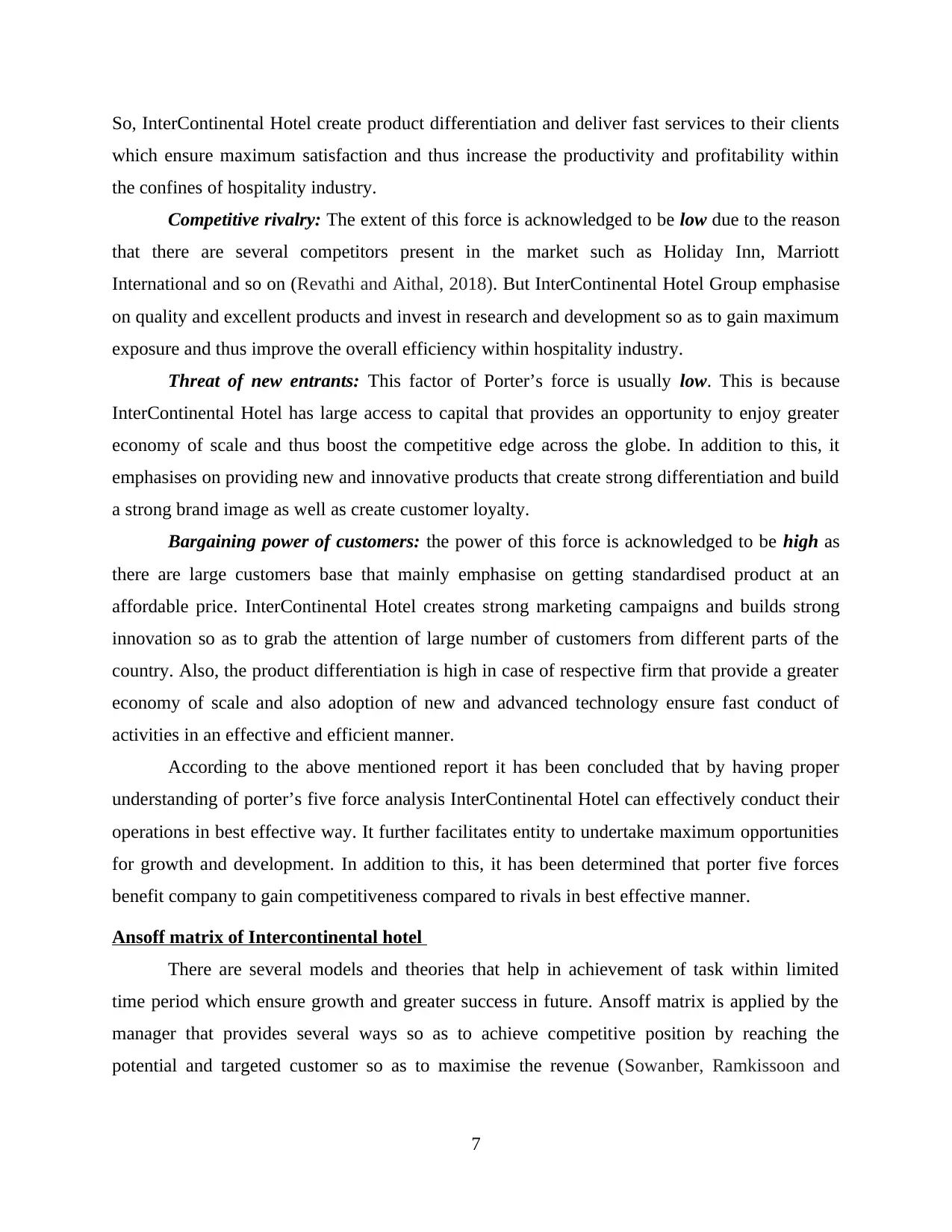
So, InterContinental Hotel create product differentiation and deliver fast services to their clients
which ensure maximum satisfaction and thus increase the productivity and profitability within
the confines of hospitality industry.
Competitive rivalry: The extent of this force is acknowledged to be low due to the reason
that there are several competitors present in the market such as Holiday Inn, Marriott
International and so on (Revathi and Aithal, 2018). But InterContinental Hotel Group emphasise
on quality and excellent products and invest in research and development so as to gain maximum
exposure and thus improve the overall efficiency within hospitality industry.
Threat of new entrants: This factor of Porter’s force is usually low. This is because
InterContinental Hotel has large access to capital that provides an opportunity to enjoy greater
economy of scale and thus boost the competitive edge across the globe. In addition to this, it
emphasises on providing new and innovative products that create strong differentiation and build
a strong brand image as well as create customer loyalty.
Bargaining power of customers: the power of this force is acknowledged to be high as
there are large customers base that mainly emphasise on getting standardised product at an
affordable price. InterContinental Hotel creates strong marketing campaigns and builds strong
innovation so as to grab the attention of large number of customers from different parts of the
country. Also, the product differentiation is high in case of respective firm that provide a greater
economy of scale and also adoption of new and advanced technology ensure fast conduct of
activities in an effective and efficient manner.
According to the above mentioned report it has been concluded that by having proper
understanding of porter’s five force analysis InterContinental Hotel can effectively conduct their
operations in best effective way. It further facilitates entity to undertake maximum opportunities
for growth and development. In addition to this, it has been determined that porter five forces
benefit company to gain competitiveness compared to rivals in best effective manner.
Ansoff matrix of Intercontinental hotel
There are several models and theories that help in achievement of task within limited
time period which ensure growth and greater success in future. Ansoff matrix is applied by the
manager that provides several ways so as to achieve competitive position by reaching the
potential and targeted customer so as to maximise the revenue (Sowanber, Ramkissoon and
7
which ensure maximum satisfaction and thus increase the productivity and profitability within
the confines of hospitality industry.
Competitive rivalry: The extent of this force is acknowledged to be low due to the reason
that there are several competitors present in the market such as Holiday Inn, Marriott
International and so on (Revathi and Aithal, 2018). But InterContinental Hotel Group emphasise
on quality and excellent products and invest in research and development so as to gain maximum
exposure and thus improve the overall efficiency within hospitality industry.
Threat of new entrants: This factor of Porter’s force is usually low. This is because
InterContinental Hotel has large access to capital that provides an opportunity to enjoy greater
economy of scale and thus boost the competitive edge across the globe. In addition to this, it
emphasises on providing new and innovative products that create strong differentiation and build
a strong brand image as well as create customer loyalty.
Bargaining power of customers: the power of this force is acknowledged to be high as
there are large customers base that mainly emphasise on getting standardised product at an
affordable price. InterContinental Hotel creates strong marketing campaigns and builds strong
innovation so as to grab the attention of large number of customers from different parts of the
country. Also, the product differentiation is high in case of respective firm that provide a greater
economy of scale and also adoption of new and advanced technology ensure fast conduct of
activities in an effective and efficient manner.
According to the above mentioned report it has been concluded that by having proper
understanding of porter’s five force analysis InterContinental Hotel can effectively conduct their
operations in best effective way. It further facilitates entity to undertake maximum opportunities
for growth and development. In addition to this, it has been determined that porter five forces
benefit company to gain competitiveness compared to rivals in best effective manner.
Ansoff matrix of Intercontinental hotel
There are several models and theories that help in achievement of task within limited
time period which ensure growth and greater success in future. Ansoff matrix is applied by the
manager that provides several ways so as to achieve competitive position by reaching the
potential and targeted customer so as to maximise the revenue (Sowanber, Ramkissoon and
7
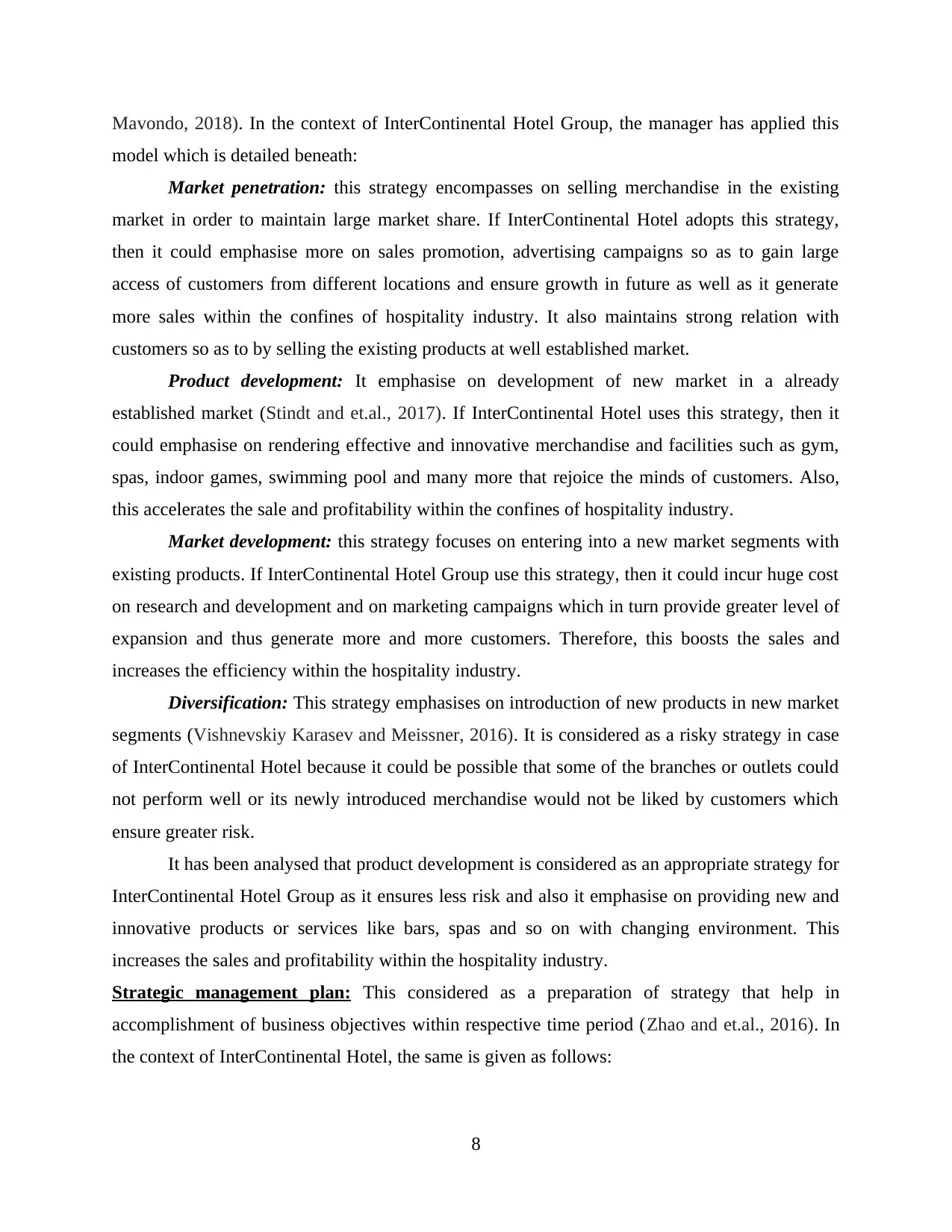
Mavondo, 2018). In the context of InterContinental Hotel Group, the manager has applied this
model which is detailed beneath:
Market penetration: this strategy encompasses on selling merchandise in the existing
market in order to maintain large market share. If InterContinental Hotel adopts this strategy,
then it could emphasise more on sales promotion, advertising campaigns so as to gain large
access of customers from different locations and ensure growth in future as well as it generate
more sales within the confines of hospitality industry. It also maintains strong relation with
customers so as to by selling the existing products at well established market.
Product development: It emphasise on development of new market in a already
established market (Stindt and et.al., 2017). If InterContinental Hotel uses this strategy, then it
could emphasise on rendering effective and innovative merchandise and facilities such as gym,
spas, indoor games, swimming pool and many more that rejoice the minds of customers. Also,
this accelerates the sale and profitability within the confines of hospitality industry.
Market development: this strategy focuses on entering into a new market segments with
existing products. If InterContinental Hotel Group use this strategy, then it could incur huge cost
on research and development and on marketing campaigns which in turn provide greater level of
expansion and thus generate more and more customers. Therefore, this boosts the sales and
increases the efficiency within the hospitality industry.
Diversification: This strategy emphasises on introduction of new products in new market
segments (Vishnevskiy Karasev and Meissner, 2016). It is considered as a risky strategy in case
of InterContinental Hotel because it could be possible that some of the branches or outlets could
not perform well or its newly introduced merchandise would not be liked by customers which
ensure greater risk.
It has been analysed that product development is considered as an appropriate strategy for
InterContinental Hotel Group as it ensures less risk and also it emphasise on providing new and
innovative products or services like bars, spas and so on with changing environment. This
increases the sales and profitability within the hospitality industry.
Strategic management plan: This considered as a preparation of strategy that help in
accomplishment of business objectives within respective time period (Zhao and et.al., 2016). In
the context of InterContinental Hotel, the same is given as follows:
8
model which is detailed beneath:
Market penetration: this strategy encompasses on selling merchandise in the existing
market in order to maintain large market share. If InterContinental Hotel adopts this strategy,
then it could emphasise more on sales promotion, advertising campaigns so as to gain large
access of customers from different locations and ensure growth in future as well as it generate
more sales within the confines of hospitality industry. It also maintains strong relation with
customers so as to by selling the existing products at well established market.
Product development: It emphasise on development of new market in a already
established market (Stindt and et.al., 2017). If InterContinental Hotel uses this strategy, then it
could emphasise on rendering effective and innovative merchandise and facilities such as gym,
spas, indoor games, swimming pool and many more that rejoice the minds of customers. Also,
this accelerates the sale and profitability within the confines of hospitality industry.
Market development: this strategy focuses on entering into a new market segments with
existing products. If InterContinental Hotel Group use this strategy, then it could incur huge cost
on research and development and on marketing campaigns which in turn provide greater level of
expansion and thus generate more and more customers. Therefore, this boosts the sales and
increases the efficiency within the hospitality industry.
Diversification: This strategy emphasises on introduction of new products in new market
segments (Vishnevskiy Karasev and Meissner, 2016). It is considered as a risky strategy in case
of InterContinental Hotel because it could be possible that some of the branches or outlets could
not perform well or its newly introduced merchandise would not be liked by customers which
ensure greater risk.
It has been analysed that product development is considered as an appropriate strategy for
InterContinental Hotel Group as it ensures less risk and also it emphasise on providing new and
innovative products or services like bars, spas and so on with changing environment. This
increases the sales and profitability within the hospitality industry.
Strategic management plan: This considered as a preparation of strategy that help in
accomplishment of business objectives within respective time period (Zhao and et.al., 2016). In
the context of InterContinental Hotel, the same is given as follows:
8
Secure Best Marks with AI Grader
Need help grading? Try our AI Grader for instant feedback on your assignments.
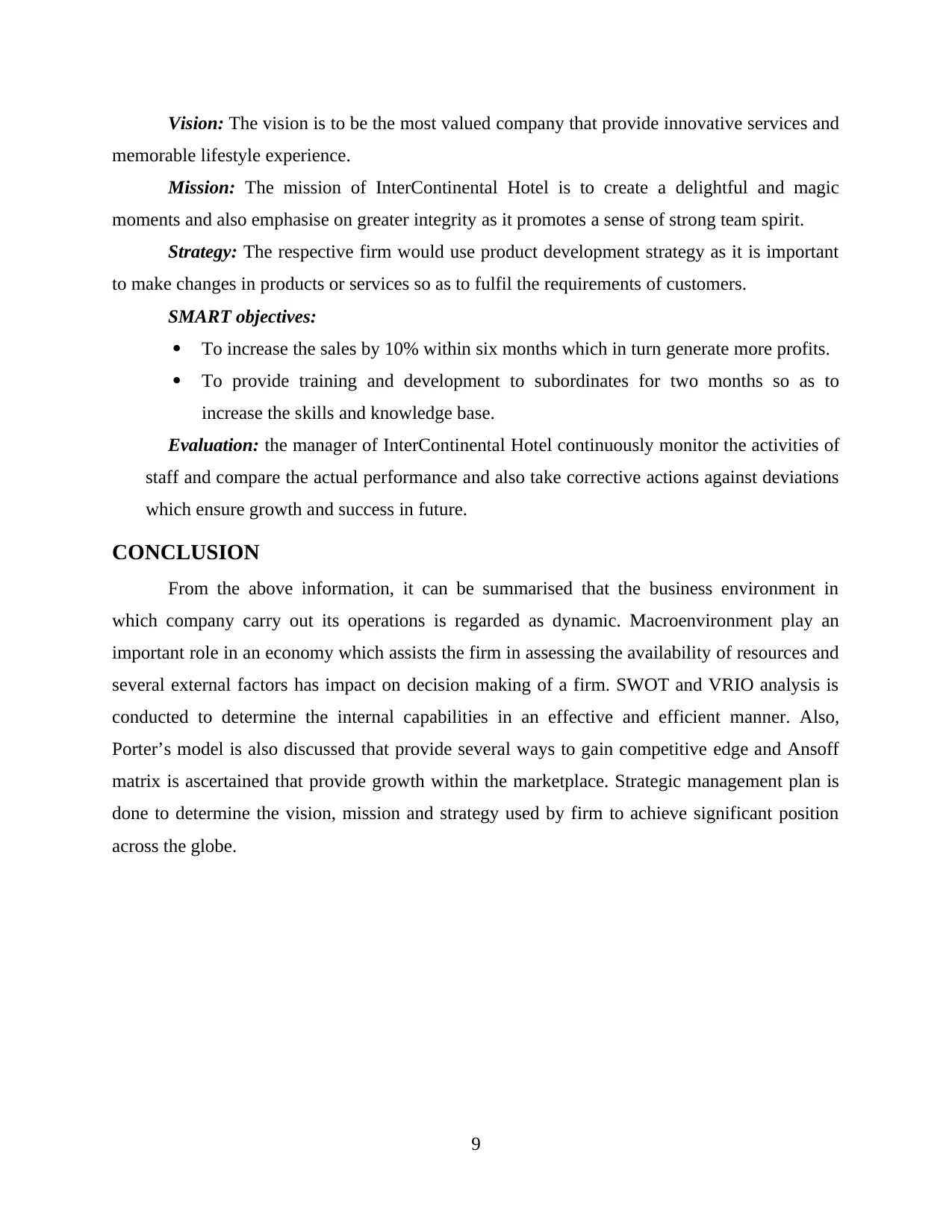
Vision: The vision is to be the most valued company that provide innovative services and
memorable lifestyle experience.
Mission: The mission of InterContinental Hotel is to create a delightful and magic
moments and also emphasise on greater integrity as it promotes a sense of strong team spirit.
Strategy: The respective firm would use product development strategy as it is important
to make changes in products or services so as to fulfil the requirements of customers.
SMART objectives:
To increase the sales by 10% within six months which in turn generate more profits.
To provide training and development to subordinates for two months so as to
increase the skills and knowledge base.
Evaluation: the manager of InterContinental Hotel continuously monitor the activities of
staff and compare the actual performance and also take corrective actions against deviations
which ensure growth and success in future.
CONCLUSION
From the above information, it can be summarised that the business environment in
which company carry out its operations is regarded as dynamic. Macroenvironment play an
important role in an economy which assists the firm in assessing the availability of resources and
several external factors has impact on decision making of a firm. SWOT and VRIO analysis is
conducted to determine the internal capabilities in an effective and efficient manner. Also,
Porter’s model is also discussed that provide several ways to gain competitive edge and Ansoff
matrix is ascertained that provide growth within the marketplace. Strategic management plan is
done to determine the vision, mission and strategy used by firm to achieve significant position
across the globe.
9
memorable lifestyle experience.
Mission: The mission of InterContinental Hotel is to create a delightful and magic
moments and also emphasise on greater integrity as it promotes a sense of strong team spirit.
Strategy: The respective firm would use product development strategy as it is important
to make changes in products or services so as to fulfil the requirements of customers.
SMART objectives:
To increase the sales by 10% within six months which in turn generate more profits.
To provide training and development to subordinates for two months so as to
increase the skills and knowledge base.
Evaluation: the manager of InterContinental Hotel continuously monitor the activities of
staff and compare the actual performance and also take corrective actions against deviations
which ensure growth and success in future.
CONCLUSION
From the above information, it can be summarised that the business environment in
which company carry out its operations is regarded as dynamic. Macroenvironment play an
important role in an economy which assists the firm in assessing the availability of resources and
several external factors has impact on decision making of a firm. SWOT and VRIO analysis is
conducted to determine the internal capabilities in an effective and efficient manner. Also,
Porter’s model is also discussed that provide several ways to gain competitive edge and Ansoff
matrix is ascertained that provide growth within the marketplace. Strategic management plan is
done to determine the vision, mission and strategy used by firm to achieve significant position
across the globe.
9
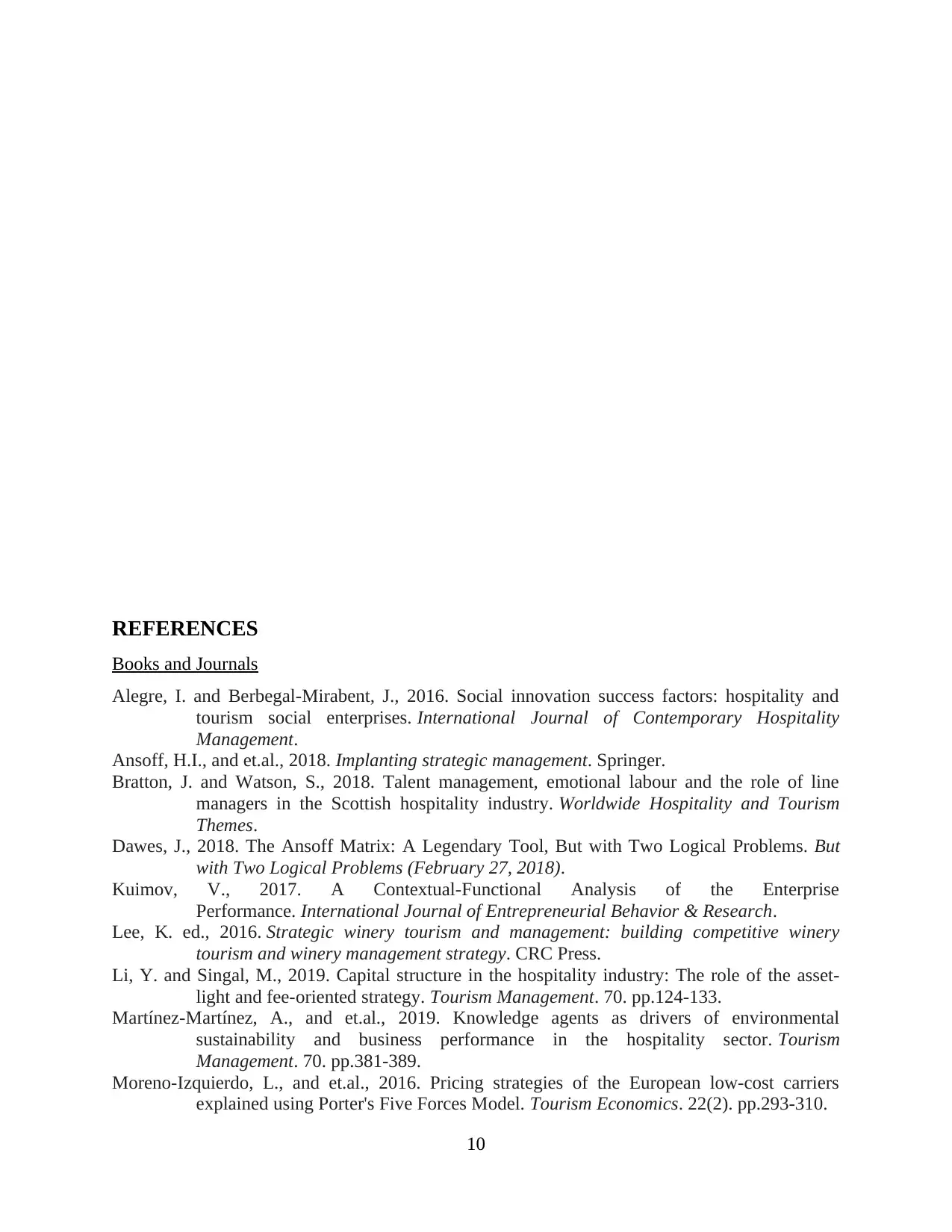
REFERENCES
Books and Journals
Alegre, I. and Berbegal-Mirabent, J., 2016. Social innovation success factors: hospitality and
tourism social enterprises. International Journal of Contemporary Hospitality
Management.
Ansoff, H.I., and et.al., 2018. Implanting strategic management. Springer.
Bratton, J. and Watson, S., 2018. Talent management, emotional labour and the role of line
managers in the Scottish hospitality industry. Worldwide Hospitality and Tourism
Themes.
Dawes, J., 2018. The Ansoff Matrix: A Legendary Tool, But with Two Logical Problems. But
with Two Logical Problems (February 27, 2018).
Kuimov, V., 2017. A Contextual-Functional Analysis of the Enterprise
Performance. International Journal of Entrepreneurial Behavior & Research.
Lee, K. ed., 2016. Strategic winery tourism and management: building competitive winery
tourism and winery management strategy. CRC Press.
Li, Y. and Singal, M., 2019. Capital structure in the hospitality industry: The role of the asset-
light and fee-oriented strategy. Tourism Management. 70. pp.124-133.
Martínez-Martínez, A., and et.al., 2019. Knowledge agents as drivers of environmental
sustainability and business performance in the hospitality sector. Tourism
Management. 70. pp.381-389.
Moreno-Izquierdo, L., and et.al., 2016. Pricing strategies of the European low-cost carriers
explained using Porter's Five Forces Model. Tourism Economics. 22(2). pp.293-310.
10
Books and Journals
Alegre, I. and Berbegal-Mirabent, J., 2016. Social innovation success factors: hospitality and
tourism social enterprises. International Journal of Contemporary Hospitality
Management.
Ansoff, H.I., and et.al., 2018. Implanting strategic management. Springer.
Bratton, J. and Watson, S., 2018. Talent management, emotional labour and the role of line
managers in the Scottish hospitality industry. Worldwide Hospitality and Tourism
Themes.
Dawes, J., 2018. The Ansoff Matrix: A Legendary Tool, But with Two Logical Problems. But
with Two Logical Problems (February 27, 2018).
Kuimov, V., 2017. A Contextual-Functional Analysis of the Enterprise
Performance. International Journal of Entrepreneurial Behavior & Research.
Lee, K. ed., 2016. Strategic winery tourism and management: building competitive winery
tourism and winery management strategy. CRC Press.
Li, Y. and Singal, M., 2019. Capital structure in the hospitality industry: The role of the asset-
light and fee-oriented strategy. Tourism Management. 70. pp.124-133.
Martínez-Martínez, A., and et.al., 2019. Knowledge agents as drivers of environmental
sustainability and business performance in the hospitality sector. Tourism
Management. 70. pp.381-389.
Moreno-Izquierdo, L., and et.al., 2016. Pricing strategies of the European low-cost carriers
explained using Porter's Five Forces Model. Tourism Economics. 22(2). pp.293-310.
10
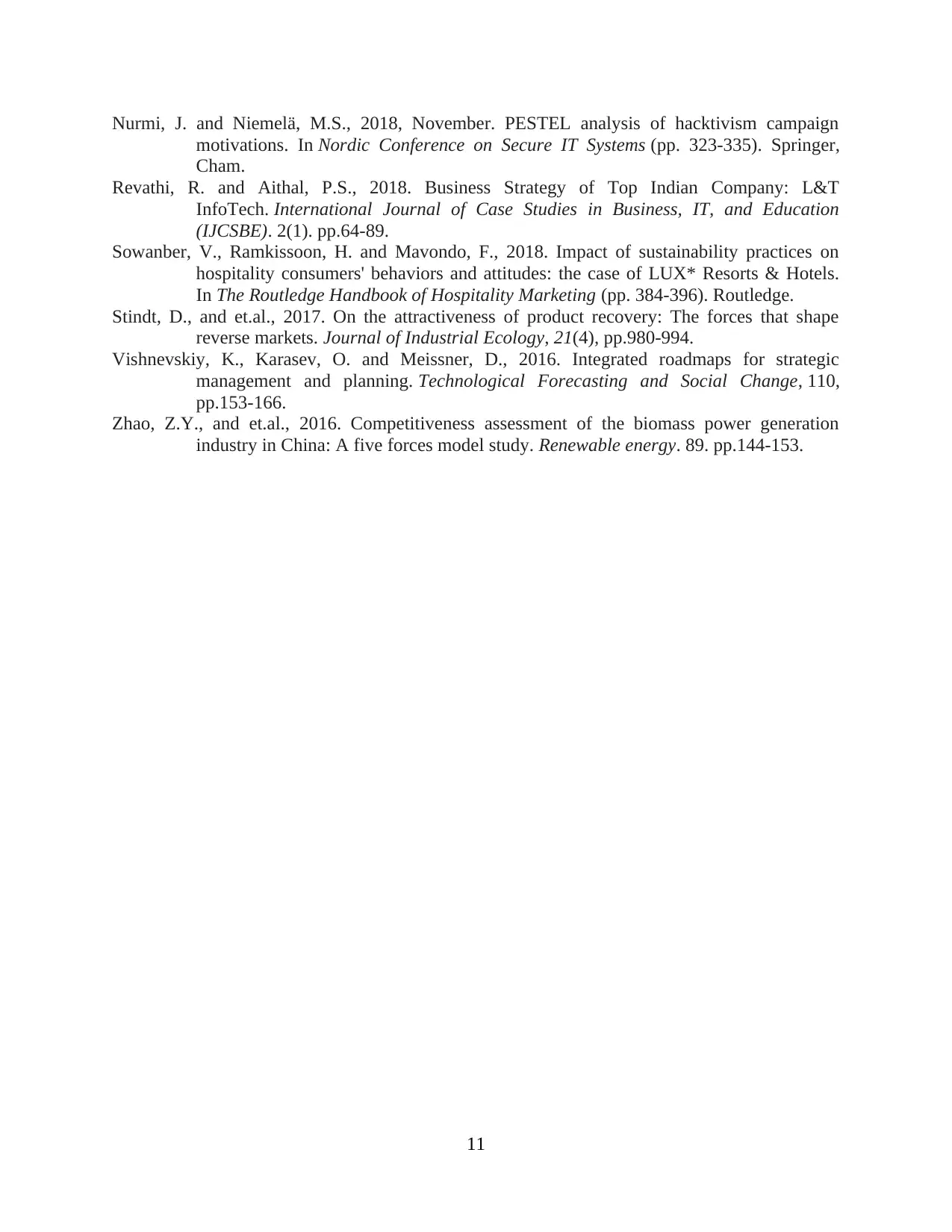
Nurmi, J. and Niemelä, M.S., 2018, November. PESTEL analysis of hacktivism campaign
motivations. In Nordic Conference on Secure IT Systems (pp. 323-335). Springer,
Cham.
Revathi, R. and Aithal, P.S., 2018. Business Strategy of Top Indian Company: L&T
InfoTech. International Journal of Case Studies in Business, IT, and Education
(IJCSBE). 2(1). pp.64-89.
Sowanber, V., Ramkissoon, H. and Mavondo, F., 2018. Impact of sustainability practices on
hospitality consumers' behaviors and attitudes: the case of LUX* Resorts & Hotels.
In The Routledge Handbook of Hospitality Marketing (pp. 384-396). Routledge.
Stindt, D., and et.al., 2017. On the attractiveness of product recovery: The forces that shape
reverse markets. Journal of Industrial Ecology, 21(4), pp.980-994.
Vishnevskiy, K., Karasev, O. and Meissner, D., 2016. Integrated roadmaps for strategic
management and planning. Technological Forecasting and Social Change, 110,
pp.153-166.
Zhao, Z.Y., and et.al., 2016. Competitiveness assessment of the biomass power generation
industry in China: A five forces model study. Renewable energy. 89. pp.144-153.
11
motivations. In Nordic Conference on Secure IT Systems (pp. 323-335). Springer,
Cham.
Revathi, R. and Aithal, P.S., 2018. Business Strategy of Top Indian Company: L&T
InfoTech. International Journal of Case Studies in Business, IT, and Education
(IJCSBE). 2(1). pp.64-89.
Sowanber, V., Ramkissoon, H. and Mavondo, F., 2018. Impact of sustainability practices on
hospitality consumers' behaviors and attitudes: the case of LUX* Resorts & Hotels.
In The Routledge Handbook of Hospitality Marketing (pp. 384-396). Routledge.
Stindt, D., and et.al., 2017. On the attractiveness of product recovery: The forces that shape
reverse markets. Journal of Industrial Ecology, 21(4), pp.980-994.
Vishnevskiy, K., Karasev, O. and Meissner, D., 2016. Integrated roadmaps for strategic
management and planning. Technological Forecasting and Social Change, 110,
pp.153-166.
Zhao, Z.Y., and et.al., 2016. Competitiveness assessment of the biomass power generation
industry in China: A five forces model study. Renewable energy. 89. pp.144-153.
11
1 out of 13
Related Documents
Your All-in-One AI-Powered Toolkit for Academic Success.
+13062052269
info@desklib.com
Available 24*7 on WhatsApp / Email
![[object Object]](/_next/static/media/star-bottom.7253800d.svg)
Unlock your academic potential
© 2024 | Zucol Services PVT LTD | All rights reserved.




